

Planet. The planets were thought by Ptolemy to orbit Earth in deferent and epicycle motions.
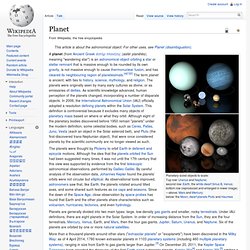
Although the idea that the planets orbited the Sun had been suggested many times, it was not until the 17th century that this view was supported by evidence from the first telescopic astronomical observations, performed by Galileo Galilei. By careful analysis of the observation data, Johannes Kepler found the planets' orbits were not circular but elliptical. As observational tools improved, astronomers saw that, like Earth, the planets rotated around tilted axes, and some shared such features as ice caps and seasons. Neptune. Neptune is similar in composition to Uranus, and both have compositions which differ from those of the larger gas giants, Jupiter, and Saturn.
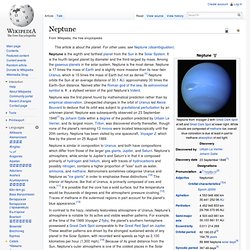
Uranus. Uranus is the seventh planet from the Sun.
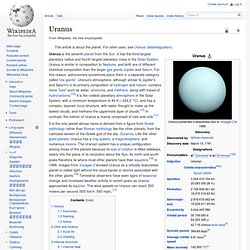
It has the third-largest planetary radius and fourth-largest planetary mass in the Solar System. Uranus is similar in composition to Neptune, and both are of different chemical composition than the larger gas giants Jupiter and Saturn. For this reason, astronomers sometimes place them in a separate category called "ice giants".
Saturn. Saturn's interior is probably composed of a core of iron, nickel and rock (silicon and oxygen compounds), surrounded by a deep layer of metallic hydrogen, an intermediate layer of liquid hydrogen and liquid helium and an outer gaseous layer.[15] The planet exhibits a pale yellow hue due to ammonia crystals in its upper atmosphere.
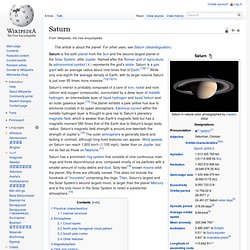
Electrical current within the metallic hydrogen layer is thought to give rise to Saturn's planetary magnetic field, which is weaker than Earth's magnetic field but has a magnetic moment 580 times that of the Earth due to Saturn's larger body radius. Saturn's magnetic field strength is around one-twentieth the strength of Jupiter's.[16] The outer atmosphere is generally bland and lacking in contrast, although long-lived features can appear.
Wind speeds on Saturn can reach 1,800 km/h (1,100 mph), faster than on Jupiter, but not as fast as those on Neptune.[17] Physical characteristics. Jupiter. Structure Jupiter is composed primarily of gaseous and liquid matter.

Mars. Animation of Mars' rotation from the vantage of an observer who moves south, then north, to hover over both poles, showing the planet's major topographic features.
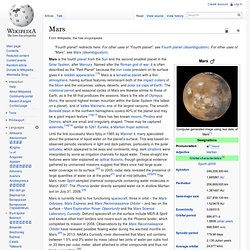
Mars is currently host to five functioning spacecraft: three in orbit – the Mars Odyssey, Mars Express, and Mars Reconnaissance Orbiter – and two on the surface – Mars Exploration Rover Opportunity and the Mars Science Laboratory Curiosity. Defunct spacecraft on the surface include MER-A Spirit and several other inert landers and rovers such as the Phoenix lander, which completed its mission in 2008.
Observations by the Mars Reconnaissance Orbiter have revealed possible flowing water during the warmest months on Mars.[25] In 2013, NASA's Curiosity rover discovered that Mars' soil contains between 1.5% and 3% water by mass (about two pints of water per cubic foot or 33 liters per cubic meter, albeit attached to other compounds and thus not freely accessible).[26] Physical characteristics Size comparison of Earth and Mars.
Soil. Venus. Venus is a terrestrial planet and is sometimes called Earth's "sister planet" because of their similar size, gravity, and bulk composition (Venus is both the closest planet to Earth and the planet closest in size to Earth).

However, it has also been shown to be very different from Earth in other respects. It has the densest atmosphere of the four terrestrial planets, consisting of more than 96% carbon dioxide. The atmospheric pressure at the planet's surface is 92 times that of Earth's. With a mean surface temperature of 735 K (462 °C; 863 °F), Venus is by far the hottest planet in the Solar System.
It has no carbon cycle to lock carbon back into rocks and surface features, nor does it seem to have any organic life to absorb it in biomass. Physical characteristics Venus is one of the four terrestrial planets in the Solar System, meaning that, like Earth, it is a rocky body. Geography The longitudes of physical features on Venus are expressed relative to its prime meridian.
Mercury (planet) Mercury is gravitationally locked and rotates in a way that is unique in the Solar System.
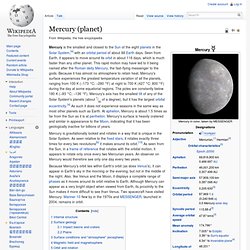
As seen relative to the fixed stars, it rotates exactly three times for every two revolutions[b] it makes around its orbit.[13] As seen from the Sun, in a frame of reference that rotates with the orbital motion, it appears to rotate only once every two Mercurian years. An observer on Mercury would therefore see only one day every two years. Because Mercury's orbit lies within Earth's orbit (as does Venus's), it can appear in Earth's sky in the morning or the evening, but not in the middle of the night.
Also, like Venus and the Moon, it displays a complete range of phases as it moves around its orbit relative to Earth. Although Mercury can appear as a very bright object when viewed from Earth, its proximity to the Sun makes it more difficult to see than Venus. Internal structure Internal structure of Mercury: 1. Mercury's density can be used to infer details of its inner structure. Surface geology.